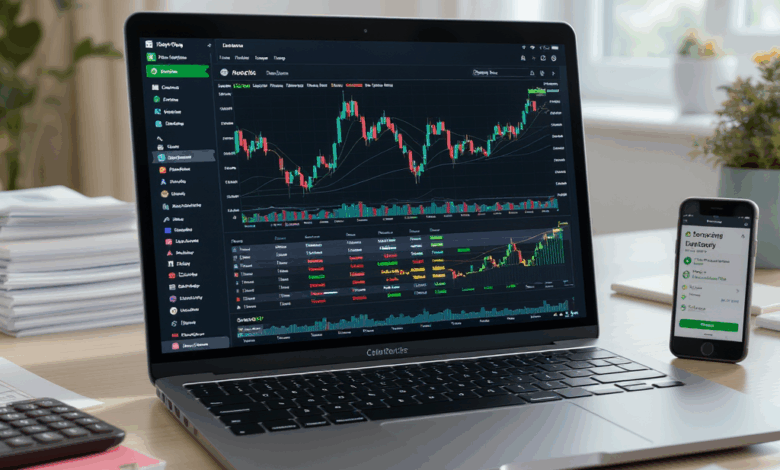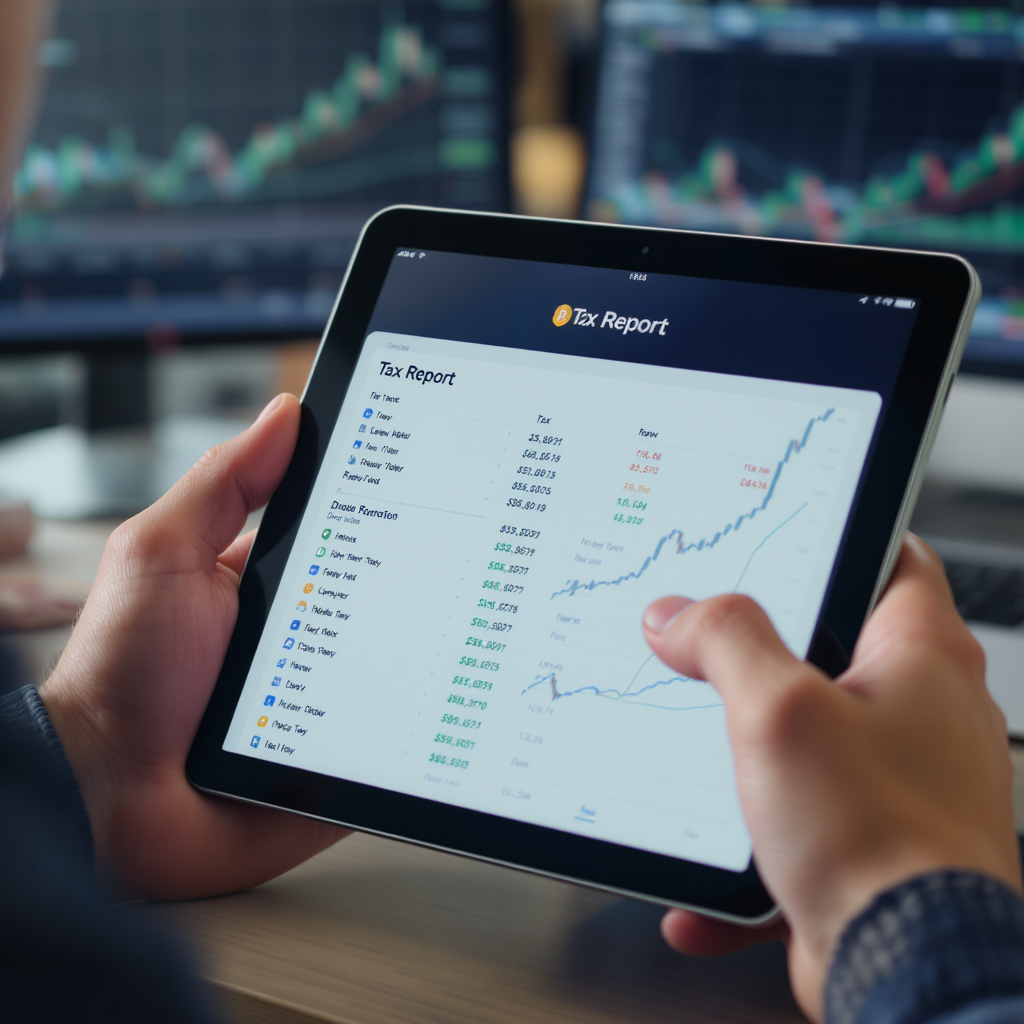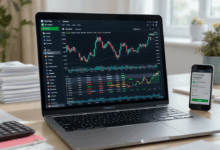Streamline Your Crypto Taxes – Master Trading Platforms with Built-in Tax Reporting in 3 Steps

Have you ever stared blankly at a mountain of transaction records, wondering how on earth you’ll explain all those trades to the tax authorities? I know I have. The complexity of tracking every buy, sell, and swap—especially in the crypto world—can quickly turn from a manageable task into an overwhelming ordeal.
Yet, amid this chaos, something intriguing is happening. Trading platforms are evolving to include tax reporting tools right at your fingertips. Imagine a system that not only logs your trades but also prepares tax-ready documents, helps you spot opportunities to reduce your tax burden, and even syncs seamlessly with popular tax software like TurboTax. It sounds almost too good to be true, doesn’t it?
But here’s the kicker: many investors still shy away from these integrated tools, either unaware of their capabilities or hesitant to trust automation with such critical information. What if this hesitation is the very barrier keeping you from simplifying your tax process?
This article isn’t just a rundown of features — it’s a step-by-step exploration designed to empower you to take control of your crypto tax reporting using these platforms. Drawing on recent developments, like TradeStation’s TurboTax integration and Koinly’s comprehensive handling of DeFi and NFTs, we’ll unpack how you can navigate and leverage these tools.
You’ll gain insight into selecting the right platform for your needs, understanding key functionalities like automated tax-loss harvesting, and making tax compliance less of a chore. Along the way, we’ll reflect on common pitfalls and share stories from others who have transformed their tax season experience.
No prior expertise required — just curiosity and a willingness to engage with your financial data in a smarter way. Because, frankly, if these tools can reduce errors, save time, and even optimize your tax outcomes, why wouldn’t we want to explore them together?
So, are you ready to turn your tax reporting from a source of stress into a streamlined part of your trading routine? Let’s dive in and take those first steps towards mastering trading platforms with built-in tax reporting.
When the Numbers Pile Up: Facing the Tax Reporting Challenge
I can’t help but think back to a time when I first tried to make sense of my own trading records. It felt like staring into a jungle of dates, prices, and transaction types, each entry a cryptic puzzle piece. If you’ve ever been there, you’ll know the sinking feeling of wondering how to accurately report all this to the tax authorities—especially when your portfolio includes cryptocurrencies that jump across wallets and exchanges like digital nomads.
But then, a curious thought struck me: what if the very platforms I was using to trade could help me tame this chaos? What if they could automatically organize my trades, generate tax reports, and even highlight ways to reduce my tax burden? This wasn’t just wishful thinking anymore—recent developments show this is becoming a reality.
Why Are Integrated Tax Reporting Tools Becoming Game-Changers?
The landscape of investing has evolved rapidly. Cryptocurrencies, NFTs, and DeFi assets have added layers of complexity that traditional tax reporting tools struggle to handle. More than that, tax authorities worldwide are intensifying scrutiny on these markets, making accuracy non-negotiable.
Platforms like TradeStation and Koinly have stepped up. TradeStation, for instance, offers direct integration with TurboTax, simplifying the import of your trading data. It’s not just about convenience; it’s about reducing errors and saving precious hours during tax season. Koinly’s reach extends across over 800 exchanges and wallets, including DeFi and NFT tracking—a critical feature considering how rapidly these assets proliferate.
These tools don’t just compile data; some even automate tax-loss harvesting, a strategy that can offset gains and thus lower taxable income. Imagine a system that spots a losing position and suggests selling it strategically—essentially becoming your personal tax advisor.
Navigating the Options How to Choose Your Platform
It’s tempting to jump on the first platform boasting these features, but a little due diligence goes a long way. Here are a few practical steps:
-
Assess Your Portfolio Complexity: Are you trading only stocks, or do you have crypto, NFTs, or DeFi assets? Platforms like ZenLedger are tailored for complex crypto portfolios, supporting hundreds of exchanges and protocols.
-
Check Software Integration: If you already use tax software like TurboTax, prioritize platforms offering seamless syncing. TradeStation’s TurboTax integration is a good example.
-
Look for Automated Features: Features like tax-loss harvesting can save time and money but are not standard everywhere.
-
Review Security Protocols: Since you’re trusting these platforms with sensitive financial data, ensure they employ strong encryption and adhere to privacy standards.
-
Trial Runs and Support: Many platforms offer free trials or demo accounts—use these to explore the interface and customer support responsiveness.
Step-by-Step: Getting Started With Integrated Tax Reporting
-
Gather Your Trading Data: Before syncing, ensure you have all your transaction histories from exchanges and wallets.
-
Choose the Right Platform: Base this on your portfolio and the criteria above.
-
Connect Your Accounts: Use API keys or upload CSV files—platforms usually offer multiple methods.
-
Review Imported Data: Check for accuracy; some platforms flag inconsistencies automatically.
-
Explore Tax Reports: Generate preliminary reports to understand your tax obligations.
-
Utilize Optimization Features: If available, activate tax-loss harvesting or other automated tools.
-
Export to Tax Software or Your Accountant: Finalize your reporting by syncing with TurboTax or sending documents to your tax professional.
-
Stay Updated: Tax laws change; keep an eye on platform updates and regulatory changes.
Watch Outs and Tips From Those Who’ve Been There
From chatting with fellow investors, a few common pitfalls emerge:
-
Ignoring Small Transactions: Micro trades can add up. Platforms that support granular data help avoid missing these.
-
Overreliance on Automation: Trust the tools, but always do your own review—automation isn’t infallible.
-
Changing Platforms Mid-Year: This can complicate reporting; consistency matters.
-
Neglecting to Backup Data: Always export and save your reports independently.
Beyond Compliance Could This Change How We Trade?
If these tools become ubiquitous, might we see investors making decisions partially based on tax strategy, not just market conditions? It’s intriguing to consider how integrated tax reporting could shift investment behaviors, encouraging more tax-efficient trading.
What do you think—are we on the cusp of a new era where tax planning and trading merge seamlessly? Or does the complexity still demand a human touch beyond automation?
Perhaps, embracing these tools isn’t just about easing a seasonal headache but about inviting a smarter, more integrated approach to investing. The journey has just begun, and together, we can navigate this evolving terrain with curiosity and caution.
So, how will you take your first step? Would you dare to let technology shoulder some of the tax burden, freeing you to focus more on the art and science of trading itself?

After wading through the tangled web of transaction records and exploring how trading platforms with built-in tax reporting tools can untangle that mess, it’s clear that these innovations are more than just convenient add-ons—they’re quietly reshaping the trading experience. By automating data compilation, offering seamless integration with tax software like TurboTax, and even suggesting strategies like tax-loss harvesting, these platforms are bridging the gap between trading complexity and tax compliance with surprising finesse. This means that what once felt like an overwhelming chore can now become a manageable—and even strategic—part of your investing routine.
The real value lies not only in time saved but in empowering you to engage with your financial data more thoughtfully and proactively. By embracing these tools, you’re not just ticking a box for tax season; you’re opening the door to smarter portfolio management and potentially more tax-efficient trading decisions.
So, how can you begin? Start by gathering your trading data and exploring platforms that align with your portfolio’s complexity and your personal comfort with automated features. Don’t hesitate to experiment with free trials and test the waters. Remember to review the imported data carefully—automation supports you, but your oversight remains crucial.
Looking ahead, as these tools evolve and become more widespread, we might see a shift where tax planning and trading merge into a more fluid, integrated practice. This raises fascinating questions about the future of investing: Will tax considerations become as instinctive as market analysis? And how will this change the way we think about risk and opportunity?
I invite you to take that first step—not just to simplify your tax reporting, but to participate in this unfolding journey toward a more intelligent approach to trading. What’s your next move? Will you let technology lighten your load and sharpen your strategy, or will you wait on the sidelines as this evolution passes by? The choice is yours, and the path forward is ripe with possibility.

